
90 Hz OLED,AdobeRGB - 联想 Yoga Pro 7 14 G10 笔记本电脑评测
专为创意人士设计的 14 英寸设备
联想更新了其 Yoga Pro 7,为第 10 代产品配备了 AMD 处理器以及全新的 14.5 英寸 OLED 显示屏,该显示屏甚至完全覆盖了 AdobeRGB 色彩空间,并可直接开箱校准。Andreas Osthoff, 👁 Andreas Osthoff (translated by DeepL / Ninh Duy) Published 🇺🇸 🇩🇪 ...
结论 - Yoga Pro 7 14 内部的 AdobeRGB OLED 是一项独特的功能
Yoga Pro 7 14 到了第十代,依然是一款优秀的全能型产品。除了在功能上略有改进(额外的 USB 端口、第二个 M.2 插槽、Wi-Fi 7)外,其全新 OLED 屏幕的 AdobeRGB 覆盖范围和极其精确的色彩配置文件尤其令人印象深刻。如果你想在 AdobeRGB 空间内随时随地工作,这款产品将是你的不二之选。
它的散热效果非常好,AMD Ryzen AI 7 350 的性能总体上还不错,但高功率限制在这款处理器上的优势并不明显。可选的 Ryzen AI 9 365(包括速度更快的 Radeon 880M GPU)应该会从 70 瓦的功率中受益更多。此外,Yoga 在省电模式下几乎保持静音。不过,一个问题是它的 100 瓦电源装置在满载情况下根本不够用。
Pros
Cons
Yoga Pro 7 14 进入了第 10 代,采用了熟悉的外壳、AMD 最新处理器和新的显示屏。我们测试了 Yoga Pro 7 14AKP10 机型(MRSP 约 1600 美元),它配备了 AMD Ryzen AI 7 350, Radeon 860M32 GB 内存、1 TB SSD 和全新 OLED 显示屏(90 Hz & AdobeRGB)。
» Notebookcheck多媒体笔记本电脑Top 10排名
» Notebookcheck游戏笔记本电脑Top 10排名
» Notebookcheck低价办公/商务笔记本电脑Top 10排名
» Notebookcheck高端办公/商务笔记本电脑Top 10排名
» Notebookcheck工作站笔记本电脑Top 10排名
» Notebookcheck亚笔记本电脑Top 10排名
» Notebookcheck超级本产品Top 10排名
» Notebookcheck变形本产品Top 10排名
» Notebookcheck平板电脑Top 10排名
» Notebookcheck智能手机Top 10排名
» Notebookcheck评测过最出色的笔记本电脑屏幕
» Notebookcheck售价500欧元以下笔记本电脑Top 10排名
» Notebookcheck售价300欧元以下笔记本电脑Top 10排名
规格
外壳和连接
其外壳与前代机型几乎没有区别 前一个模型.铝制外壳(绿松石色或灰色)继续保持良好的稳定性和制造质量。笔记本的铰链做得很好,最大开启角度接近 180 度。摄像头凸起非常隐蔽,指纹似乎也不是大问题。不过,在内部设计上,新款 Yoga Pro 7 与 IdeaPad Pro 5 14 和 IdeaPad Pro 5 14 有很多共同之处。 IdeaPad Pro 5 14有很多共同之处,我们最近也测试过它。
在端口方面,设备右侧增加了第二个 USB-A 端口,而两个 USB 4.0 端口保持不变。它的 WLAN 模块支持 Wi-Fi 7 和蓝牙 5.4,在我们的测试中,它的速度被证明是超快的。笔记本电脑的网络摄像头也升级为 500 万像素传感器。它支持 Studio Effects,我们的测试设备是 Copilot+ 笔记本电脑。
| Networking | |
| Lenovo Yoga Pro 7 14AKP G10 | |
| iperf3 transmit AXE11000 | |
| iperf3 receive AXE11000 | |
| Acer Swift 14 AI SF14-51-58TU | |
| iperf3 transmit AXE11000 | |
| iperf3 receive AXE11000 | |
| SCHENKER XMG Evo 14 (M24) | |
| iperf3 transmit AXE11000 | |
| iperf3 receive AXE11000 | |
| Asus VivoBook S 14 OLED M5406WA | |
| iperf3 transmit AXE11000 | |
| iperf3 receive AXE11000 | |
| Xiaomi RedmiBook Pro 14 2025 | |
| iperf3 transmit AXE11000 | |
| iperf3 receive AXE11000 | |
| Lenovo Yoga Pro 7 14ASP G9 | |
| iperf3 transmit AXE11000 | |
| iperf3 receive AXE11000 | |

可持续性
Yoga Pro 7 符合多项环保标准(如能源之星、EPEAT Gold、碳中性),并使用部分回收铝材。其包装完全不含塑料。
输入设备 - 1.5 毫米行程
显示屏 - 2.9K OLED,AdobeRGB 覆盖范围
| |||||||||||||||||||||||||
Brightness Distribution: 98 %
Center on Battery: 474 cd/m²
Contrast: ∞:1 (Black: 0 cd/m²)
ΔE Color 1.3 | 0.5-29.43 Ø4.87
ΔE Greyscale 1.7 | 0.5-98 Ø5.1
98.1% AdobeRGB 1998 (Argyll 2.2.0 3D)
100% sRGB (Argyll 2.2.0 3D)
97.1% Display P3 (Argyll 2.2.0 3D)
Gamma: 2.19
| Lenovo Yoga Pro 7 14AKP G10 LEN145WQ+, OLED, 2944x1840, 14.5", 90 Hz | Acer Swift 14 AI SF14-51-58TU Samsung ATNA40YK11-0 (SDC4181), OLED, 2880x1800, 14", 90 Hz | SCHENKER XMG Evo 14 (M24) MNE007ZA3-2, IPS, 2880x1800, 14", 120 Hz | Asus VivoBook S 14 OLED M5406WA ATNA40CT02-0 (SDC41A0), OLED, 1920x1200, 14", 60 Hz | Xiaomi RedmiBook Pro 14 2025 MNE007ZA3-5, IPS, 2880x1800, 14", 120 Hz | Lenovo Yoga Pro 7 14ASP G9 LEN145WQ+, OLED, 3072x1920, 14.5", 120 Hz | |
|---|---|---|---|---|---|---|
| Display | 1% | -18% | 1% | -18% | -3% | |
| Display P3 Coverage | 97.1 | 99.9 3% | 71 -27% | 99.9 3% | 70.3 -28% | 98 1% |
| sRGB Coverage | 100 | 100 0% | 99.9 0% | 100 0% | 99.6 0% | 99.9 0% |
| AdobeRGB 1998 Coverage | 98.1 | 97.6 -1% | 72.8 -26% | 97.2 -1% | 71.9 -27% | 88.1 -10% |
| Response Times | -57% | -3753% | -96% | -3638% | -5% | |
| Response Time Grey 50% / Grey 80% * | 0.45 ? | 0.8 ? -78% | 26.3 ? -5744% | 1.3 ? -189% | 26.7 ? -5833% | 0.44 ? 2% |
| Response Time Black / White * | 0.72 ? | 0.8 ? -11% | 13.4 ? -1761% | 1.2 ? -67% | 11.1 ? -1442% | 0.61 ? 15% |
| PWM Frequency | 360 | 60 ? -83% | 240 ? -33% | 240 ? -33% | ||
| Screen | -52% | 1% | -12% | -10% | 3% | |
| Brightness middle | 474 | 500 5% | 421 -11% | 385 -19% | 516 9% | 400 -16% |
| Brightness | 475 | 499 5% | 412 -13% | 382 -20% | 518 9% | 403 -15% |
| Brightness Distribution | 98 | 97 -1% | 90 -8% | 95 -3% | 95 -3% | 97 -1% |
| Black Level * | 0.01 | 0.32 | 0.03 | 0.37 | ||
| Colorchecker dE 2000 * | 1.3 | 3.55 -173% | 1.3 -0% | 1.99 -53% | 1.7 -31% | 1 23% |
| Colorchecker dE 2000 max. * | 2.9 | 6.38 -120% | 2.4 17% | 3.69 -27% | 3.2 -10% | 2.8 3% |
| Greyscale dE 2000 * | 1.7 | 2.2 -29% | 1.4 18% | 0.8 53% | 2.3 -35% | 1.3 24% |
| Gamma | 2.19 100% | 1.94 113% | 2.14 103% | 2.204 100% | 2.25 98% | 2.23 99% |
| CCT | 6690 97% | 6405 101% | 6446 101% | 6474 100% | 6942 94% | 6586 99% |
| Contrast | 50000 | 1316 | 12833 | 1395 | ||
| Colorchecker dE 2000 calibrated * | 2.55 | 1.1 | 1.79 | 1.1 | ||
| Total Average (Program / Settings) | -36% /
-40% | -1257% /
-687% | -36% /
-30% | -1222% /
-672% | -2% /
-1% |
* ... smaller is better
我们使用专业的 CalMAN 软件对面板进行了分析。联想表示显示器在出厂时已经过校准,我们也证实了这一点。所有三种色彩空间(SRGB、P3 和 AdobeRGB)都有准确的配置文件,几乎完全覆盖。因此,您可以毫无问题地编辑图像。我们无法通过自己的校准进一步改善显示效果。
Display Response Times
| ↔ Response Time Black to White | ||
|---|---|---|
| 0.72 ms ... rise ↗ and fall ↘ combined | ↗ 0.4 ms rise | |
| ↘ 0.32 ms fall | ||
| The screen shows very fast response rates in our tests and should be very well suited for fast-paced gaming. In comparison, all tested devices range from 0.1 (minimum) to 240 (maximum) ms. » 1 % of all devices are better. This means that the measured response time is better than the average of all tested devices (20.7 ms). | ||
| ↔ Response Time 50% Grey to 80% Grey | ||
| 0.45 ms ... rise ↗ and fall ↘ combined | ↗ 0.24 ms rise | |
| ↘ 0.21 ms fall | ||
| The screen shows very fast response rates in our tests and should be very well suited for fast-paced gaming. In comparison, all tested devices range from 0.165 (minimum) to 636 (maximum) ms. » 0 % of all devices are better. This means that the measured response time is better than the average of all tested devices (32.5 ms). | ||
Screen Flickering / PWM (Pulse-Width Modulation)
| Screen flickering / PWM detected | 360 Hz Amplitude: 33 % | ||
The display backlight flickers at 360 Hz (worst case, e.g., utilizing PWM) . The frequency of 360 Hz is relatively high, so most users sensitive to PWM should not notice any flickering. However, there are reports that some users are still sensitive to PWM at 500 Hz and above, so be aware. In comparison: 53 % of all tested devices do not use PWM to dim the display. If PWM was detected, an average of 8508 (minimum: 5 - maximum: 343500) Hz was measured. | |||
性能 - AMD Ryzen AI 和 32 GB 内存
联想为 Yoga Pro 7 14 配备了 Ryzen AI 7 350(Krackan点、 Radeon 860M)或 Ryzen AI 9 365(Strix点、 Radeon 880M),每款均配备 32 GB 内存(LPDDR5x-8000,板载)。
测试条件
联想提供三种不同的能源配置文件(省电、自动、性能),它们与 Windows 设置相关联。我们在性能模式下运行了以下基准测试。不过,对于简单的任务,省电模式也完全够用,设备几乎没有噪音。
| 能源概况 | CPU TDP | Cinebench 2024 Multi | Time Spy 图形 | 最大风扇噪音排放 |
|---|---|---|---|---|
| 省电模式 | 24/20 瓦 | 672 分 | 2,515 分 | 24 dB(A) |
| 自动 | 62/50 瓦 | 930 分 | 2,866 分 | 39.2 dB(A) |
| 性能 | 85/70 瓦 | 973 分 | 2,987 分 | 45.4 分贝(A) |
处理器 - Ryzen AI 7 350
......(英文 Ryzen AI 7 350Ryzen AI 7 350 有 8 个内核(16 个线程),除了 4 个 Zen 5 内核(最高 5 GHz)外,还使用了 4 个速度较慢的 Zen 5c 内核(最高 3.5 GHz,缓存较少)。其功耗限制非常高,达到 85/70 瓦,但 Ryzen AI 7 仍落后于诸如 Ryzen AI 9 365或 酷睿至尊 7 255H等机型。在连续负载和电池模式下,其性能保持稳定。
Cinebench R15 Multi continuous test
Cinebench R23: Multi Core | Single Core
Cinebench R20: CPU (Multi Core) | CPU (Single Core)
Cinebench R15: CPU Multi 64Bit | CPU Single 64Bit
Blender: v2.79 BMW27 CPU
7-Zip 18.03: 7z b 4 | 7z b 4 -mmt1
Geekbench 6.4: Multi-Core | Single-Core
Geekbench 5.5: Multi-Core | Single-Core
HWBOT x265 Benchmark v2.2: 4k Preset
LibreOffice : 20 Documents To PDF
R Benchmark 2.5: Overall mean
| CPU Performance Rating | |
| Xiaomi RedmiBook Pro 14 2025 | |
| Asus VivoBook S 14 OLED M5406WA | |
| Lenovo Yoga Pro 7 14ASP G9 | |
| Lenovo Yoga Pro 7 14AKP G10 | |
| Average AMD Ryzen AI 7 350 | |
| SCHENKER XMG Evo 14 (M24) | |
| Average of class Subnotebook | |
| Acer Swift 14 AI SF14-51-58TU | |
| Cinebench R23 / Multi Core | |
| Asus VivoBook S 14 OLED M5406WA | |
| Xiaomi RedmiBook Pro 14 2025 | |
| Lenovo Yoga Pro 7 14ASP G9 | |
| Lenovo Yoga Pro 7 14AKP G10 | |
| Average AMD Ryzen AI 7 350 (14383 - 17899, n=5) | |
| SCHENKER XMG Evo 14 (M24) | |
| Average of class Subnotebook (1555 - 21812, n=75, last 2 years) | |
| Acer Swift 14 AI SF14-51-58TU | |
| Cinebench R23 / Single Core | |
| Xiaomi RedmiBook Pro 14 2025 | |
| Asus VivoBook S 14 OLED M5406WA | |
| Lenovo Yoga Pro 7 14ASP G9 | |
| Average AMD Ryzen AI 7 350 (1943 - 2006, n=5) | |
| Lenovo Yoga Pro 7 14AKP G10 | |
| SCHENKER XMG Evo 14 (M24) | |
| Acer Swift 14 AI SF14-51-58TU | |
| Average of class Subnotebook (358 - 2165, n=75, last 2 years) | |
| Cinebench R20 / CPU (Multi Core) | |
| Asus VivoBook S 14 OLED M5406WA | |
| Xiaomi RedmiBook Pro 14 2025 | |
| Lenovo Yoga Pro 7 14ASP G9 | |
| Lenovo Yoga Pro 7 14AKP G10 | |
| Average AMD Ryzen AI 7 350 (5483 - 6990, n=4) | |
| SCHENKER XMG Evo 14 (M24) | |
| Average of class Subnotebook (579 - 8541, n=70, last 2 years) | |
| Acer Swift 14 AI SF14-51-58TU | |
| Cinebench R20 / CPU (Single Core) | |
| Xiaomi RedmiBook Pro 14 2025 | |
| Asus VivoBook S 14 OLED M5406WA | |
| Lenovo Yoga Pro 7 14ASP G9 | |
| Average AMD Ryzen AI 7 350 (761 - 784, n=4) | |
| Lenovo Yoga Pro 7 14AKP G10 | |
| SCHENKER XMG Evo 14 (M24) | |
| Acer Swift 14 AI SF14-51-58TU | |
| Average of class Subnotebook (128 - 826, n=70, last 2 years) | |
| Cinebench R15 / CPU Multi 64Bit | |
| Asus VivoBook S 14 OLED M5406WA | |
| Xiaomi RedmiBook Pro 14 2025 | |
| Lenovo Yoga Pro 7 14ASP G9 | |
| Lenovo Yoga Pro 7 14AKP G10 | |
| Average AMD Ryzen AI 7 350 (2419 - 2660, n=4) | |
| SCHENKER XMG Evo 14 (M24) | |
| Average of class Subnotebook (327 - 3345, n=75, last 2 years) | |
| Acer Swift 14 AI SF14-51-58TU | |
| Cinebench R15 / CPU Single 64Bit | |
| Xiaomi RedmiBook Pro 14 2025 | |
| Asus VivoBook S 14 OLED M5406WA | |
| Lenovo Yoga Pro 7 14ASP G9 | |
| Average AMD Ryzen AI 7 350 (294 - 305, n=4) | |
| Lenovo Yoga Pro 7 14AKP G10 | |
| SCHENKER XMG Evo 14 (M24) | |
| Acer Swift 14 AI SF14-51-58TU | |
| Average of class Subnotebook (72.4 - 322, n=71, last 2 years) | |
| Blender / v2.79 BMW27 CPU | |
| Average of class Subnotebook (159 - 2271, n=74, last 2 years) | |
| Acer Swift 14 AI SF14-51-58TU | |
| SCHENKER XMG Evo 14 (M24) | |
| Average AMD Ryzen AI 7 350 (183 - 246, n=4) | |
| Lenovo Yoga Pro 7 14ASP G9 | |
| Lenovo Yoga Pro 7 14AKP G10 | |
| Xiaomi RedmiBook Pro 14 2025 | |
| Asus VivoBook S 14 OLED M5406WA | |
| 7-Zip 18.03 / 7z b 4 | |
| Asus VivoBook S 14 OLED M5406WA | |
| SCHENKER XMG Evo 14 (M24) | |
| Xiaomi RedmiBook Pro 14 2025 | |
| Lenovo Yoga Pro 7 14ASP G9 | |
| Lenovo Yoga Pro 7 14AKP G10 | |
| Average AMD Ryzen AI 7 350 (48124 - 63807, n=4) | |
| Average of class Subnotebook (11668 - 77867, n=66, last 2 years) | |
| Acer Swift 14 AI SF14-51-58TU | |
| 7-Zip 18.03 / 7z b 4 -mmt1 | |
| SCHENKER XMG Evo 14 (M24) | |
| Xiaomi RedmiBook Pro 14 2025 | |
| Average AMD Ryzen AI 7 350 (6042 - 6162, n=4) | |
| Lenovo Yoga Pro 7 14AKP G10 | |
| Asus VivoBook S 14 OLED M5406WA | |
| Lenovo Yoga Pro 7 14ASP G9 | |
| Average of class Subnotebook (2643 - 6442, n=68, last 2 years) | |
| Acer Swift 14 AI SF14-51-58TU | |
| Geekbench 6.4 / Multi-Core | |
| Xiaomi RedmiBook Pro 14 2025 | |
| Asus VivoBook S 14 OLED M5406WA | |
| Lenovo Yoga Pro 7 14ASP G9 | |
| Lenovo Yoga Pro 7 14AKP G10 | |
| SCHENKER XMG Evo 14 (M24) | |
| Average AMD Ryzen AI 7 350 (10774 - 14028, n=4) | |
| Average of class Subnotebook (2244 - 17489, n=74, last 2 years) | |
| Acer Swift 14 AI SF14-51-58TU | |
| Geekbench 6.4 / Single-Core | |
| Xiaomi RedmiBook Pro 14 2025 | |
| Asus VivoBook S 14 OLED M5406WA | |
| Average AMD Ryzen AI 7 350 (2836 - 2882, n=4) | |
| Lenovo Yoga Pro 7 14AKP G10 | |
| Lenovo Yoga Pro 7 14ASP G9 | |
| Average of class Subnotebook (960 - 3820, n=69, last 2 years) | |
| Acer Swift 14 AI SF14-51-58TU | |
| SCHENKER XMG Evo 14 (M24) | |
| Geekbench 5.5 / Multi-Core | |
| Xiaomi RedmiBook Pro 14 2025 | |
| Asus VivoBook S 14 OLED M5406WA | |
| Lenovo Yoga Pro 7 14ASP G9 | |
| Lenovo Yoga Pro 7 14AKP G10 | |
| SCHENKER XMG Evo 14 (M24) | |
| Average AMD Ryzen AI 7 350 (9997 - 12458, n=4) | |
| Average of class Subnotebook (2557 - 17218, n=67, last 2 years) | |
| Acer Swift 14 AI SF14-51-58TU | |
| Geekbench 5.5 / Single-Core | |
| Lenovo Yoga Pro 7 14AKP G10 | |
| Xiaomi RedmiBook Pro 14 2025 | |
| Asus VivoBook S 14 OLED M5406WA | |
| Lenovo Yoga Pro 7 14ASP G9 | |
| Average AMD Ryzen AI 7 350 (1955 - 2135, n=4) | |
| SCHENKER XMG Evo 14 (M24) | |
| Acer Swift 14 AI SF14-51-58TU | |
| Average of class Subnotebook (726 - 2350, n=67, last 2 years) | |
| HWBOT x265 Benchmark v2.2 / 4k Preset | |
| Xiaomi RedmiBook Pro 14 2025 | |
| Lenovo Yoga Pro 7 14AKP G10 | |
| Average AMD Ryzen AI 7 350 (19.4 - 22.9, n=4) | |
| Asus VivoBook S 14 OLED M5406WA | |
| Lenovo Yoga Pro 7 14ASP G9 | |
| SCHENKER XMG Evo 14 (M24) | |
| Average of class Subnotebook (0.97 - 25.1, n=69, last 2 years) | |
| Acer Swift 14 AI SF14-51-58TU | |
| LibreOffice / 20 Documents To PDF | |
| Acer Swift 14 AI SF14-51-58TU | |
| Average AMD Ryzen AI 7 350 (50.4 - 66.5, n=4) | |
| Average of class Subnotebook (38.5 - 220, n=67, last 2 years) | |
| Asus VivoBook S 14 OLED M5406WA | |
| Lenovo Yoga Pro 7 14AKP G10 | |
| Lenovo Yoga Pro 7 14ASP G9 | |
| SCHENKER XMG Evo 14 (M24) | |
| Xiaomi RedmiBook Pro 14 2025 | |
| R Benchmark 2.5 / Overall mean | |
| Average of class Subnotebook (0.403 - 1.456, n=69, last 2 years) | |
| Acer Swift 14 AI SF14-51-58TU | |
| SCHENKER XMG Evo 14 (M24) | |
| Xiaomi RedmiBook Pro 14 2025 | |
| Lenovo Yoga Pro 7 14ASP G9 | |
| Lenovo Yoga Pro 7 14AKP G10 | |
| Asus VivoBook S 14 OLED M5406WA | |
| Average AMD Ryzen AI 7 350 (0.403 - 0.4189, n=4) | |
* ... smaller is better
AIDA64: FP32 Ray-Trace | FPU Julia | CPU SHA3 | CPU Queen | FPU SinJulia | FPU Mandel | CPU AES | CPU ZLib | FP64 Ray-Trace | CPU PhotoWorxx
| Performance Rating | |
| Asus VivoBook S 14 OLED M5406WA | |
| Lenovo Yoga Pro 7 14ASP G9 | |
| Lenovo Yoga Pro 7 14AKP G10 | |
| SCHENKER XMG Evo 14 (M24) | |
| Xiaomi RedmiBook Pro 14 2025 | |
| Average AMD Ryzen AI 7 350 | |
| Average of class Subnotebook | |
| Acer Swift 14 AI SF14-51-58TU | |
| AIDA64 / FP32 Ray-Trace | |
| Asus VivoBook S 14 OLED M5406WA | |
| Lenovo Yoga Pro 7 14ASP G9 | |
| Lenovo Yoga Pro 7 14AKP G10 | |
| Average AMD Ryzen AI 7 350 (22795 - 27796, n=4) | |
| SCHENKER XMG Evo 14 (M24) | |
| Xiaomi RedmiBook Pro 14 2025 | |
| Average of class Subnotebook (1135 - 32888, n=69, last 2 years) | |
| Acer Swift 14 AI SF14-51-58TU | |
| AIDA64 / FPU Julia | |
| Asus VivoBook S 14 OLED M5406WA | |
| Lenovo Yoga Pro 7 14ASP G9 | |
| Lenovo Yoga Pro 7 14AKP G10 | |
| SCHENKER XMG Evo 14 (M24) | |
| Average AMD Ryzen AI 7 350 (87919 - 107379, n=4) | |
| Xiaomi RedmiBook Pro 14 2025 | |
| Acer Swift 14 AI SF14-51-58TU | |
| Average of class Subnotebook (5218 - 123315, n=69, last 2 years) | |
| AIDA64 / CPU SHA3 | |
| Asus VivoBook S 14 OLED M5406WA | |
| Lenovo Yoga Pro 7 14ASP G9 | |
| Xiaomi RedmiBook Pro 14 2025 | |
| SCHENKER XMG Evo 14 (M24) | |
| Lenovo Yoga Pro 7 14AKP G10 | |
| Average AMD Ryzen AI 7 350 (3764 - 4301, n=4) | |
| Average of class Subnotebook (444 - 5287, n=69, last 2 years) | |
| Acer Swift 14 AI SF14-51-58TU | |
| AIDA64 / CPU Queen | |
| SCHENKER XMG Evo 14 (M24) | |
| Lenovo Yoga Pro 7 14ASP G9 | |
| Asus VivoBook S 14 OLED M5406WA | |
| Lenovo Yoga Pro 7 14AKP G10 | |
| Average AMD Ryzen AI 7 350 (67317 - 77400, n=4) | |
| Average of class Subnotebook (10579 - 115682, n=69, last 2 years) | |
| Xiaomi RedmiBook Pro 14 2025 | |
| Acer Swift 14 AI SF14-51-58TU | |
| AIDA64 / FPU SinJulia | |
| Asus VivoBook S 14 OLED M5406WA | |
| Lenovo Yoga Pro 7 14ASP G9 | |
| SCHENKER XMG Evo 14 (M24) | |
| Lenovo Yoga Pro 7 14AKP G10 | |
| Average AMD Ryzen AI 7 350 (12671 - 13677, n=4) | |
| Xiaomi RedmiBook Pro 14 2025 | |
| Average of class Subnotebook (744 - 18418, n=69, last 2 years) | |
| Acer Swift 14 AI SF14-51-58TU | |
| AIDA64 / FPU Mandel | |
| Asus VivoBook S 14 OLED M5406WA | |
| Lenovo Yoga Pro 7 14ASP G9 | |
| Lenovo Yoga Pro 7 14AKP G10 | |
| Average AMD Ryzen AI 7 350 (46152 - 57717, n=4) | |
| SCHENKER XMG Evo 14 (M24) | |
| Xiaomi RedmiBook Pro 14 2025 | |
| Acer Swift 14 AI SF14-51-58TU | |
| Average of class Subnotebook (3341 - 65433, n=69, last 2 years) | |
| AIDA64 / CPU AES | |
| Lenovo Yoga Pro 7 14AKP G10 | |
| SCHENKER XMG Evo 14 (M24) | |
| Asus VivoBook S 14 OLED M5406WA | |
| Xiaomi RedmiBook Pro 14 2025 | |
| Average AMD Ryzen AI 7 350 (56915 - 84374, n=4) | |
| Lenovo Yoga Pro 7 14ASP G9 | |
| Average of class Subnotebook (638 - 161430, n=69, last 2 years) | |
| Acer Swift 14 AI SF14-51-58TU | |
| AIDA64 / CPU ZLib | |
| Asus VivoBook S 14 OLED M5406WA | |
| Lenovo Yoga Pro 7 14ASP G9 | |
| Xiaomi RedmiBook Pro 14 2025 | |
| Lenovo Yoga Pro 7 14AKP G10 | |
| Average AMD Ryzen AI 7 350 (1043 - 1117, n=4) | |
| SCHENKER XMG Evo 14 (M24) | |
| Average of class Subnotebook (164.9 - 1379, n=69, last 2 years) | |
| Acer Swift 14 AI SF14-51-58TU | |
| AIDA64 / FP64 Ray-Trace | |
| Asus VivoBook S 14 OLED M5406WA | |
| Lenovo Yoga Pro 7 14ASP G9 | |
| Lenovo Yoga Pro 7 14AKP G10 | |
| Average AMD Ryzen AI 7 350 (12177 - 14991, n=4) | |
| SCHENKER XMG Evo 14 (M24) | |
| Xiaomi RedmiBook Pro 14 2025 | |
| Average of class Subnotebook (610 - 17495, n=69, last 2 years) | |
| Acer Swift 14 AI SF14-51-58TU | |
| AIDA64 / CPU PhotoWorxx | |
| Xiaomi RedmiBook Pro 14 2025 | |
| Lenovo Yoga Pro 7 14ASP G9 | |
| Acer Swift 14 AI SF14-51-58TU | |
| Asus VivoBook S 14 OLED M5406WA | |
| Lenovo Yoga Pro 7 14AKP G10 | |
| Average of class Subnotebook (6569 - 64588, n=69, last 2 years) | |
| SCHENKER XMG Evo 14 (M24) | |
| Average AMD Ryzen AI 7 350 (25283 - 47405, n=4) | |
系统性能
Yoga Pro 7 14 在合成系统测试中表现出色,没有发现任何问题。在实际使用过程中,该设备的快速响应时间和无挂起现象也给人留下了深刻印象。
CrossMark: Overall | Productivity | Creativity | Responsiveness
WebXPRT 3: Overall
WebXPRT 4: Overall
Mozilla Kraken 1.1: Total
| PCMark 10 / Score | |
| Xiaomi RedmiBook Pro 14 2025 | |
| Asus VivoBook S 14 OLED M5406WA | |
| Lenovo Yoga Pro 7 14ASP G9 | |
| Lenovo Yoga Pro 7 14AKP G10 | |
| SCHENKER XMG Evo 14 (M24) | |
| Average AMD Ryzen AI 7 350, AMD Radeon 860M (6982 - 7416, n=3) | |
| Average of class Subnotebook (4993 - 7788, n=58, last 2 years) | |
| Acer Swift 14 AI SF14-51-58TU | |
| PCMark 10 / Essentials | |
| Lenovo Yoga Pro 7 14AKP G10 | |
| Lenovo Yoga Pro 7 14ASP G9 | |
| Average AMD Ryzen AI 7 350, AMD Radeon 860M (10801 - 11312, n=3) | |
| SCHENKER XMG Evo 14 (M24) | |
| Xiaomi RedmiBook Pro 14 2025 | |
| Asus VivoBook S 14 OLED M5406WA | |
| Average of class Subnotebook (9363 - 11331, n=58, last 2 years) | |
| Acer Swift 14 AI SF14-51-58TU | |
| PCMark 10 / Productivity | |
| Asus VivoBook S 14 OLED M5406WA | |
| Lenovo Yoga Pro 7 14ASP G9 | |
| SCHENKER XMG Evo 14 (M24) | |
| Lenovo Yoga Pro 7 14AKP G10 | |
| Average AMD Ryzen AI 7 350, AMD Radeon 860M (9674 - 10040, n=3) | |
| Xiaomi RedmiBook Pro 14 2025 | |
| Average of class Subnotebook (5435 - 10623, n=58, last 2 years) | |
| Acer Swift 14 AI SF14-51-58TU | |
| PCMark 10 / Digital Content Creation | |
| Xiaomi RedmiBook Pro 14 2025 | |
| Asus VivoBook S 14 OLED M5406WA | |
| Lenovo Yoga Pro 7 14ASP G9 | |
| Lenovo Yoga Pro 7 14AKP G10 | |
| SCHENKER XMG Evo 14 (M24) | |
| Average AMD Ryzen AI 7 350, AMD Radeon 860M (8842 - 9911, n=3) | |
| Acer Swift 14 AI SF14-51-58TU | |
| Average of class Subnotebook (5305 - 12442, n=58, last 2 years) | |
| CrossMark / Overall | |
| Xiaomi RedmiBook Pro 14 2025 | |
| Lenovo Yoga Pro 7 14AKP G10 | |
| Average AMD Ryzen AI 7 350, AMD Radeon 860M (1696 - 2005, n=4) | |
| SCHENKER XMG Evo 14 (M24) | |
| Lenovo Yoga Pro 7 14ASP G9 | |
| Average of class Subnotebook (365 - 2038, n=68, last 2 years) | |
| CrossMark / Productivity | |
| Xiaomi RedmiBook Pro 14 2025 | |
| Average AMD Ryzen AI 7 350, AMD Radeon 860M (1624 - 1869, n=4) | |
| Lenovo Yoga Pro 7 14AKP G10 | |
| SCHENKER XMG Evo 14 (M24) | |
| Average of class Subnotebook (364 - 1918, n=68, last 2 years) | |
| Lenovo Yoga Pro 7 14ASP G9 | |
| CrossMark / Creativity | |
| Xiaomi RedmiBook Pro 14 2025 | |
| Lenovo Yoga Pro 7 14AKP G10 | |
| Average AMD Ryzen AI 7 350, AMD Radeon 860M (1887 - 2236, n=4) | |
| Lenovo Yoga Pro 7 14ASP G9 | |
| SCHENKER XMG Evo 14 (M24) | |
| Average of class Subnotebook (372 - 2396, n=68, last 2 years) | |
| CrossMark / Responsiveness | |
| Average AMD Ryzen AI 7 350, AMD Radeon 860M (1401 - 1784, n=4) | |
| Lenovo Yoga Pro 7 14AKP G10 | |
| Xiaomi RedmiBook Pro 14 2025 | |
| SCHENKER XMG Evo 14 (M24) | |
| Average of class Subnotebook (312 - 1899, n=68, last 2 years) | |
| Lenovo Yoga Pro 7 14ASP G9 | |
| WebXPRT 3 / Overall | |
| Lenovo Yoga Pro 7 14AKP G10 | |
| Lenovo Yoga Pro 7 14ASP G9 | |
| Average AMD Ryzen AI 7 350, AMD Radeon 860M (295 - 328, n=4) | |
| Average of class Subnotebook (156 - 482, n=67, last 2 years) | |
| Xiaomi RedmiBook Pro 14 2025 | |
| SCHENKER XMG Evo 14 (M24) | |
| WebXPRT 4 / Overall | |
| SCHENKER XMG Evo 14 (M24) | |
| Xiaomi RedmiBook Pro 14 2025 | |
| Lenovo Yoga Pro 7 14AKP G10 | |
| Average AMD Ryzen AI 7 350, AMD Radeon 860M (249 - 275, n=4) | |
| Average of class Subnotebook (132 - 348, n=68, last 2 years) | |
| Lenovo Yoga Pro 7 14ASP G9 | |
| Asus VivoBook S 14 OLED M5406WA | |
| Acer Swift 14 AI SF14-51-58TU | |
| Acer Swift 14 AI SF14-51-58TU | |
| Mozilla Kraken 1.1 / Total | |
| SCHENKER XMG Evo 14 (M24) | |
| Acer Swift 14 AI SF14-51-58TU | |
| Acer Swift 14 AI SF14-51-58TU | |
| Average of class Subnotebook (265 - 1104, n=76, last 2 years) | |
| Xiaomi RedmiBook Pro 14 2025 | |
| Lenovo Yoga Pro 7 14ASP G9 | |
| Lenovo Yoga Pro 7 14AKP G10 | |
| Average AMD Ryzen AI 7 350, AMD Radeon 860M (436 - 437, n=4) | |
| Asus VivoBook S 14 OLED M5406WA | |
| Asus VivoBook S 14 OLED M5406WA | |
* ... smaller is better
| PCMark 10 Score | 7416 points | |
Help | ||
| AIDA64 / Memory Copy | |
| Lenovo Yoga Pro 7 14AKP G10 | |
| Xiaomi RedmiBook Pro 14 2025 | |
| Acer Swift 14 AI SF14-51-58TU | |
| Asus VivoBook S 14 OLED M5406WA | |
| Lenovo Yoga Pro 7 14ASP G9 | |
| Average AMD Ryzen AI 7 350 (38001 - 106997, n=4) | |
| Average of class Subnotebook (14554 - 109035, n=69, last 2 years) | |
| SCHENKER XMG Evo 14 (M24) | |
| AIDA64 / Memory Read | |
| Asus VivoBook S 14 OLED M5406WA | |
| Lenovo Yoga Pro 7 14ASP G9 | |
| Acer Swift 14 AI SF14-51-58TU | |
| Xiaomi RedmiBook Pro 14 2025 | |
| Average of class Subnotebook (15948 - 122210, n=69, last 2 years) | |
| Lenovo Yoga Pro 7 14AKP G10 | |
| SCHENKER XMG Evo 14 (M24) | |
| Average AMD Ryzen AI 7 350 (44209 - 63650, n=4) | |
| AIDA64 / Memory Write | |
| Acer Swift 14 AI SF14-51-58TU | |
| Lenovo Yoga Pro 7 14AKP G10 | |
| Lenovo Yoga Pro 7 14ASP G9 | |
| Asus VivoBook S 14 OLED M5406WA | |
| Average AMD Ryzen AI 7 350 (42604 - 107869, n=4) | |
| SCHENKER XMG Evo 14 (M24) | |
| Xiaomi RedmiBook Pro 14 2025 | |
| Average of class Subnotebook (15709 - 117898, n=69, last 2 years) | |
| AIDA64 / Memory Latency | |
| Xiaomi RedmiBook Pro 14 2025 | |
| Lenovo Yoga Pro 7 14ASP G9 | |
| Asus VivoBook S 14 OLED M5406WA | |
| Average of class Subnotebook (7.2 - 187.8, n=68, last 2 years) | |
| Lenovo Yoga Pro 7 14AKP G10 | |
| Average AMD Ryzen AI 7 350 (87.7 - 103.3, n=4) | |
| Acer Swift 14 AI SF14-51-58TU | |
| SCHENKER XMG Evo 14 (M24) | |
* ... smaller is better
| DPC Latencies / LatencyMon - interrupt to process latency (max), Web, Youtube, Prime95 | |
| Lenovo Yoga Pro 7 14ASP G9 | |
| Acer Swift 14 AI SF14-51-58TU | |
| Xiaomi RedmiBook Pro 14 2025 | |
| Asus VivoBook S 14 OLED M5406WA | |
| SCHENKER XMG Evo 14 (M24) | |
| Lenovo Yoga Pro 7 14AKP G10 | |
* ... smaller is better
存储设备
* ... smaller is better
Reading continuous performance: DiskSpd Read Loop, Queue Depth 8
图形卡
Ryzen AI 7 350 配备了集成的 Radeon 860M显卡,仅次于速度更快的 Radeon 880M/890M和 Arc Graphics 140V/140T它的性能完全可以满足日常多媒体使用,但如果您想玩一两款零星的游戏,我们建议您使用速度更快的 Ryzen AI 9 365 和 Radeon 880M在这种情况下,您的性能储备会更多一些。在长时间负载和电池模式下,Gpu 的性能仍然完全稳定。
| 3DMark 11 Performance | 12124 points | |
| 3DMark Fire Strike Score | 7229 points | |
| 3DMark Time Spy Score | 3347 points | |
| 3DMark Steel Nomad Score | 487 points | |
| 3DMark Steel Nomad Light Score | 2571 points | |
| 3DMark Steel Nomad Light Unlimited Score | 2556 points | |
Help | ||
| Blender / v3.3 Classroom CPU | |
| Acer Swift 14 AI SF14-51-58TU | |
| Average of class Subnotebook (241 - 1127, n=72, last 2 years) | |
| SCHENKER XMG Evo 14 (M24) | |
| Average AMD Radeon 860M (283 - 381, n=4) | |
| Lenovo Yoga Pro 7 14ASP G9 | |
| Xiaomi RedmiBook Pro 14 2025 | |
| Lenovo Yoga Pro 7 14AKP G10 | |
| Asus VivoBook S 14 OLED M5406WA | |
* ... smaller is better
| Cyberpunk 2077 2.2 Phantom Liberty - 1920x1080 Ultra Preset (FSR off) | |
| Xiaomi RedmiBook Pro 14 2025 | |
| Asus VivoBook S 14 OLED M5406WA | |
| Acer Swift 14 AI SF14-51-58TU | |
| SCHENKER XMG Evo 14 (M24) | |
| Lenovo Yoga Pro 7 14ASP G9 | |
| Lenovo Yoga Pro 7 14AKP G10 | |
| Average of class Subnotebook (8.48 - 31.4, n=49, last 2 years) | |
| GTA V - 1920x1080 Highest Settings possible AA:4xMSAA + FX AF:16x | |
| Lenovo Yoga Pro 7 14ASP G9 | |
| Asus VivoBook S 14 OLED M5406WA | |
| Lenovo Yoga Pro 7 14AKP G10 | |
| SCHENKER XMG Evo 14 (M24) | |
| Acer Swift 14 AI SF14-51-58TU | |
| Average of class Subnotebook (7.81 - 53, n=66, last 2 years) | |
| Xiaomi RedmiBook Pro 14 2025 | |
Cyberpunk 2077 ultra FPS diagram
| low | med. | high | ultra | |
|---|---|---|---|---|
| GTA V (2015) | 173.8 | 153.3 | 76 | 30.7 |
| Dota 2 Reborn (2015) | 167.5 | 139.5 | 84.8 | 78.7 |
| Final Fantasy XV Benchmark (2018) | 83.9 | 39.2 | 27.4 | |
| X-Plane 11.11 (2018) | 73.6 | 58.4 | 47.8 | |
| Strange Brigade (2018) | 177.3 | 70.8 | 58.7 | 48.5 |
| Baldur's Gate 3 (2023) | 37 | 30.1 | 23.6 | 22.9 |
| Cyberpunk 2077 2.2 Phantom Liberty (2023) | 42.8 | 32.8 | 25.5 | 20.9 |
排放与能源
噪音排放
Noise Level
| Idle |
| 23.5 / 23.5 / 23.5 dB(A) |
| Load |
| 45.5 / 45.5 dB(A) |
 | ||
30 dB silent 40 dB(A) audible 50 dB(A) loud |
||
min: | ||
| Lenovo Yoga Pro 7 14AKP G10 Radeon 860M, Ryzen AI 7 350, SK hynix PVC10 HFS001TEM4X182N | Acer Swift 14 AI SF14-51-58TU Arc 130V, Core Ultra 5 226V, Micron 2550 512GB | SCHENKER XMG Evo 14 (M24) Radeon 780M, R7 8845HS, Samsung 990 Pro 1 TB | Asus VivoBook S 14 OLED M5406WA Radeon 890M, Ryzen AI 9 HX 370, Micron 2400 MTFDKBA1T0QFM | Xiaomi RedmiBook Pro 14 2025 Arc 140T, Ultra 7 255H, YMTC PC411-1TB | Lenovo Yoga Pro 7 14ASP G9 Radeon 880M, Ryzen AI 9 365, Micron 2550 1TB MTFDKCD1T0TGE | |
|---|---|---|---|---|---|---|
| Noise | -2% | 3% | 2% | 5% | 3% | |
| off / environment * | 23.5 | 25 -6% | 24.7 -5% | 24 -2% | 23.8 -1% | 23.8 -1% |
| Idle Minimum * | 23.5 | 25 -6% | 24.7 -5% | 24 -2% | 23.8 -1% | 23.8 -1% |
| Idle Average * | 23.5 | 26 -11% | 24.7 -5% | 25 -6% | 23.8 -1% | 23.8 -1% |
| Idle Maximum * | 23.5 | 29 -23% | 26.3 -12% | 27 -15% | 23.8 -1% | 23.8 -1% |
| Load Average * | 45.5 | 40 12% | 37.6 17% | 40 12% | 30 34% | 44.6 2% |
| Cyberpunk 2077 ultra * | 45.5 | 40 12% | 37.6 17% | 39 14% | 42.2 7% | 35.9 21% |
| Load Maximum * | 45.5 | 41 10% | 37.6 17% | 40 12% | 45.3 -0% | 44.6 2% |
* ... smaller is better
温度
(±) The maximum temperature on the upper side is 43.1 °C / 110 F, compared to the average of 35.9 °C / 97 F, ranging from 21.4 to 59 °C for the class Subnotebook.
(±) The bottom heats up to a maximum of 41.4 °C / 107 F, compared to the average of 39.3 °C / 103 F
(+) In idle usage, the average temperature for the upper side is 25.9 °C / 79 F, compared to the device average of 30.8 °C / 87 F.
(±) 3: The average temperature for the upper side is 34.7 °C / 94 F, compared to the average of 30.8 °C / 87 F for the class Subnotebook.
(+) The palmrests and touchpad are cooler than skin temperature with a maximum of 28.7 °C / 83.7 F and are therefore cool to the touch.
(±) The average temperature of the palmrest area of similar devices was 28.2 °C / 82.8 F (-0.5 °C / -0.9 F).
| Lenovo Yoga Pro 7 14AKP G10 AMD Ryzen AI 7 350, AMD Radeon 860M | Acer Swift 14 AI SF14-51-58TU Intel Core Ultra 5 226V, Intel Arc Graphics 130V | SCHENKER XMG Evo 14 (M24) AMD Ryzen 7 8845HS, AMD Radeon 780M | Asus VivoBook S 14 OLED M5406WA AMD Ryzen AI 9 HX 370, AMD Radeon 890M | Xiaomi RedmiBook Pro 14 2025 Intel Core Ultra 7 255H, Intel Arc Graphics 140T | Lenovo Yoga Pro 7 14ASP G9 AMD Ryzen AI 9 365, AMD Radeon 880M | |
|---|---|---|---|---|---|---|
| Heat | -2% | -6% | -18% | -6% | -2% | |
| Maximum Upper Side * | 43.1 | 41 5% | 41.7 3% | 49 -14% | 41.9 3% | 42 3% |
| Maximum Bottom * | 41.4 | 45 -9% | 50.1 -21% | 59 -43% | 52.1 -26% | 40.6 2% |
| Idle Upper Side * | 26.5 | 26 2% | 27.1 -2% | 28 -6% | 26.3 1% | 28.2 -6% |
| Idle Bottom * | 26.8 | 28 -4% | 27.7 -3% | 29 -8% | 27.4 -2% | 28.9 -8% |
* ... smaller is better
发言人
笔记本电脑的音响系统由四个模块组成(两个高音/低音扬声器,每个 2 瓦)。它的最大音量有点低,但音质仍然非常好,空间感很强。在这方面,Yoga 也领先于同类设备。
Lenovo Yoga Pro 7 14AKP G10 audio analysis
(±) | speaker loudness is average but good (76.3 dB)
Bass 100 - 315 Hz
(±) | reduced bass - on average 5.4% lower than median
(±) | linearity of bass is average (10.3% delta to prev. frequency)
Mids 400 - 2000 Hz
(+) | balanced mids - only 2.4% away from median
(+) | mids are linear (3.6% delta to prev. frequency)
Highs 2 - 16 kHz
(+) | balanced highs - only 2.4% away from median
(+) | highs are linear (4.4% delta to prev. frequency)
Overall 100 - 16.000 Hz
(+) | overall sound is linear (9.4% difference to median)
Compared to same class
» 4% of all tested devices in this class were better, 2% similar, 94% worse
» The best had a delta of 5%, average was 19%, worst was 53%
Compared to all devices tested
» 3% of all tested devices were better, 1% similar, 96% worse
» The best had a delta of 4%, average was 24%, worst was 134%
Acer Swift 14 AI SF14-51-58TU audio analysis
(+) | speakers can play relatively loud (84 dB)
Bass 100 - 315 Hz
(-) | nearly no bass - on average 21.5% lower than median
(±) | linearity of bass is average (7.5% delta to prev. frequency)
Mids 400 - 2000 Hz
(±) | higher mids - on average 8.3% higher than median
(±) | linearity of mids is average (7.6% delta to prev. frequency)
Highs 2 - 16 kHz
(+) | balanced highs - only 3.2% away from median
(+) | highs are linear (2.9% delta to prev. frequency)
Overall 100 - 16.000 Hz
(±) | linearity of overall sound is average (20.3% difference to median)
Compared to same class
» 63% of all tested devices in this class were better, 9% similar, 28% worse
» The best had a delta of 5%, average was 19%, worst was 53%
Compared to all devices tested
» 50% of all tested devices were better, 8% similar, 42% worse
» The best had a delta of 4%, average was 24%, worst was 134%
SCHENKER XMG Evo 14 (M24) audio analysis
(±) | speaker loudness is average but good (81.7 dB)
Bass 100 - 315 Hz
(-) | nearly no bass - on average 18.1% lower than median
(±) | linearity of bass is average (10.2% delta to prev. frequency)
Mids 400 - 2000 Hz
(±) | higher mids - on average 5.2% higher than median
(+) | mids are linear (5.5% delta to prev. frequency)
Highs 2 - 16 kHz
(+) | balanced highs - only 3.6% away from median
(+) | highs are linear (5.3% delta to prev. frequency)
Overall 100 - 16.000 Hz
(±) | linearity of overall sound is average (16% difference to median)
Compared to same class
» 37% of all tested devices in this class were better, 6% similar, 57% worse
» The best had a delta of 5%, average was 18%, worst was 45%
Compared to all devices tested
» 23% of all tested devices were better, 5% similar, 72% worse
» The best had a delta of 4%, average was 24%, worst was 134%
Asus VivoBook S 14 OLED M5406WA audio analysis
(±) | speaker loudness is average but good (81 dB)
Bass 100 - 315 Hz
(±) | reduced bass - on average 14% lower than median
(±) | linearity of bass is average (13.1% delta to prev. frequency)
Mids 400 - 2000 Hz
(+) | balanced mids - only 4.3% away from median
(+) | mids are linear (5.4% delta to prev. frequency)
Highs 2 - 16 kHz
(+) | balanced highs - only 3.4% away from median
(±) | linearity of highs is average (7.3% delta to prev. frequency)
Overall 100 - 16.000 Hz
(+) | overall sound is linear (14.2% difference to median)
Compared to same class
» 26% of all tested devices in this class were better, 6% similar, 68% worse
» The best had a delta of 5%, average was 19%, worst was 53%
Compared to all devices tested
» 15% of all tested devices were better, 4% similar, 81% worse
» The best had a delta of 4%, average was 24%, worst was 134%
Xiaomi RedmiBook Pro 14 2025 audio analysis
(+) | speakers can play relatively loud (84.4 dB)
Bass 100 - 315 Hz
(±) | reduced bass - on average 12.1% lower than median
(±) | linearity of bass is average (8.3% delta to prev. frequency)
Mids 400 - 2000 Hz
(±) | higher mids - on average 5.7% higher than median
(+) | mids are linear (4.7% delta to prev. frequency)
Highs 2 - 16 kHz
(+) | balanced highs - only 1.4% away from median
(+) | highs are linear (3.8% delta to prev. frequency)
Overall 100 - 16.000 Hz
(+) | overall sound is linear (12.9% difference to median)
Compared to same class
» 18% of all tested devices in this class were better, 5% similar, 77% worse
» The best had a delta of 5%, average was 19%, worst was 53%
Compared to all devices tested
» 11% of all tested devices were better, 3% similar, 87% worse
» The best had a delta of 4%, average was 24%, worst was 134%
Lenovo Yoga Pro 7 14ASP G9 audio analysis
(±) | speaker loudness is average but good (75.3 dB)
Bass 100 - 315 Hz
(±) | reduced bass - on average 11.4% lower than median
(±) | linearity of bass is average (10.3% delta to prev. frequency)
Mids 400 - 2000 Hz
(+) | balanced mids - only 3% away from median
(+) | mids are linear (6.9% delta to prev. frequency)
Highs 2 - 16 kHz
(+) | balanced highs - only 3.9% away from median
(+) | highs are linear (4.5% delta to prev. frequency)
Overall 100 - 16.000 Hz
(+) | overall sound is linear (14.2% difference to median)
Compared to same class
» 26% of all tested devices in this class were better, 6% similar, 68% worse
» The best had a delta of 5%, average was 19%, worst was 53%
Compared to all devices tested
» 15% of all tested devices were better, 4% similar, 81% worse
» The best had a delta of 4%, average was 24%, worst was 134%
耗电量
| Off / Standby | |
| Idle | |
| Load |
|
Key:
min: | |
| Lenovo Yoga Pro 7 14AKP G10 Ryzen AI 7 350, Radeon 860M, SK hynix PVC10 HFS001TEM4X182N, OLED, 2944x1840, 14.5" | Acer Swift 14 AI SF14-51-58TU Core Ultra 5 226V, Arc 130V, Micron 2550 512GB, OLED, 2880x1800, 14" | SCHENKER XMG Evo 14 (M24) R7 8845HS, Radeon 780M, Samsung 990 Pro 1 TB, IPS, 2880x1800, 14" | Asus VivoBook S 14 OLED M5406WA Ryzen AI 9 HX 370, Radeon 890M, Micron 2400 MTFDKBA1T0QFM, OLED, 1920x1200, 14" | Xiaomi RedmiBook Pro 14 2025 Ultra 7 255H, Arc 140T, YMTC PC411-1TB, IPS, 2880x1800, 14" | Lenovo Yoga Pro 7 14ASP G9 Ryzen AI 9 365, Radeon 880M, Micron 2550 1TB MTFDKCD1T0TGE, OLED, 3072x1920, 14.5" | |
|---|---|---|---|---|---|---|
| Power Consumption | 28% | 8% | -6% | 1% | 6% | |
| Idle Minimum * | 5.4 | 5 7% | 4.6 15% | 6 -11% | 5.2 4% | 5.5 -2% |
| Idle Average * | 7.4 | 6 19% | 7.8 -5% | 8 -8% | 9.3 -26% | 7.6 -3% |
| Idle Maximum * | 7.9 | 10 -27% | 8 -1% | 14 -77% | 10.3 -30% | 7.9 -0% |
| Load Average * | 65.7 | 36 45% | 71.7 -9% | 76 -16% | 56.5 14% | 77.9 -19% |
| Cyberpunk 2077 ultra * | 85.3 | 41.6 51% | 71.4 16% | 58.6 31% | 70 18% | 63 26% |
| Cyberpunk 2077 ultra external monitor * | 84.7 | 38.2 55% | 68.5 19% | 61.9 27% | 65 23% | 61.5 27% |
| Load Maximum * | 105.1 | 60 43% | 83 21% | 94 11% | 101.8 3% | 94.8 10% |
* ... smaller is better
Power consumption Cyberpunk / stress test
Power consumption with external monitor
运行时间
Notebookcheck 总评分
Lenovo Yoga Pro 7 14AKP G10
- 04/19/2025 v8
Andreas Osthoff
Possible alternatives compared
Image | Model / Review | Price | Weight | Height | Display |
|---|---|---|---|---|---|
| Lenovo Yoga Pro 7 14AKP G10 AMD Ryzen AI 7 350 ⎘ AMD Radeon 860M ⎘ 32 GB Memory, 1024 GB SSD | Amazon: 1. $980.00 Lenovo Yoga Pro 7 14AHP9-202... 2. $2,149.00 Lenovo Yoga Pro 9i 16"" Lapt... 3. $849.98 Lenovo Yoga 7 7i 2-in-1 Lapt... List Price: 1399€ | 1.6 kg | 17.4 mm | 14.50" 2944x1840 239 PPI OLED | |
| Acer Swift 14 AI SF14-51-58TU Intel Core Ultra 5 226V ⎘ Intel Arc Graphics 130V ⎘ 16 GB Memory, 512 GB SSD | List Price: 1200 EUR | 1.3 kg | 16 mm | 14.00" 2880x1800 243 PPI OLED | |
| SCHENKER XMG Evo 14 (M24) AMD Ryzen 7 8845HS ⎘ AMD Radeon 780M ⎘ 32 GB Memory, 1024 GB SSD | List Price: 1200€ | 1.5 kg | 17 mm | 14.00" 2880x1800 243 PPI IPS | |
| Asus VivoBook S 14 OLED M5406WA AMD Ryzen AI 9 HX 370 ⎘ AMD Radeon 890M ⎘ 24 GB Memory, 1024 GB SSD | Amazon: $1,199.99 List Price: 1400 EUR | 1.3 kg | 15.9 mm | 14.00" 1920x1200 162 PPI OLED | |
| Xiaomi RedmiBook Pro 14 2025 Intel Core Ultra 7 255H ⎘ Intel Arc Graphics 140T ⎘ 32 GB Memory, 1024 GB SSD | Amazon: 1. $15.99 Vaxson 2-Pack Film Protector... 2. $20.99 Vaxson 3-Pack Screen Protect... 3. $30.95 celicious Impact Anti-Shock ... List Price: 1090€ | 1.4 kg | 15.9 mm | 14.00" 2880x1800 243 PPI IPS | |
| Lenovo Yoga Pro 7 14ASP G9 AMD Ryzen AI 9 365 ⎘ AMD Radeon 880M ⎘ 32 GB Memory, 1024 GB SSD | Amazon: 1. $980.00 Lenovo Yoga Pro 7 14AHP9-202... 2. $1,099.99 Lenovo Yoga Pro 7 14AHP9 Lap... 3. $53.99 Laptop Case Cover for 14 inc... List Price: 1599€ | 1.5 kg | 18 mm | 14.50" 3072x1920 250 PPI OLED |
Transparency
The selection of devices to be reviewed is made by our editorial team. The test sample was provided to the author as a loan by the manufacturer or retailer for the purpose of this review. The lender had no influence on this review, nor did the manufacturer receive a copy of this review before publication. There was no obligation to publish this review. We never accept compensation or payment in return for our reviews. As an independent media company, Notebookcheck is not subjected to the authority of manufacturers, retailers or publishers.
This is how Notebookcheck is testing
Every year, Notebookcheck independently reviews hundreds of laptops and smartphones using standardized procedures to ensure that all results are comparable. We have continuously developed our test methods for around 20 years and set industry standards in the process. In our test labs, high-quality measuring equipment is utilized by experienced technicians and editors. These tests involve a multi-stage validation process. Our complex rating system is based on hundreds of well-founded measurements and benchmarks, which maintains objectivity. Further information on our test methods can be found here.















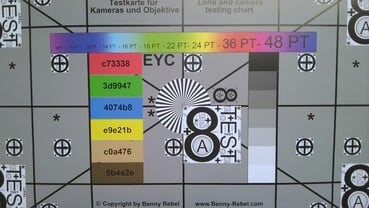
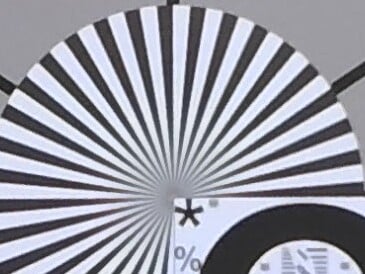


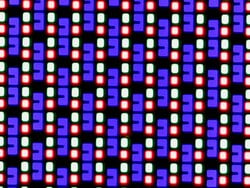












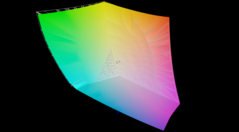
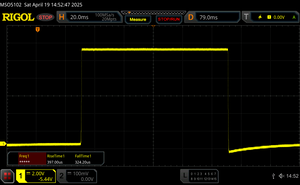
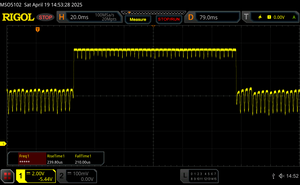


















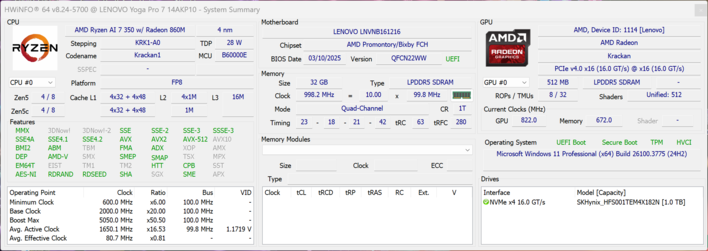






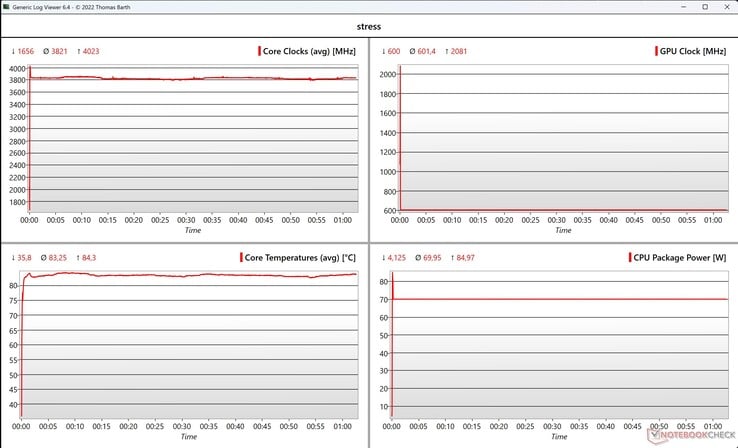





 Total Sustainability Score:
Total Sustainability Score: 














